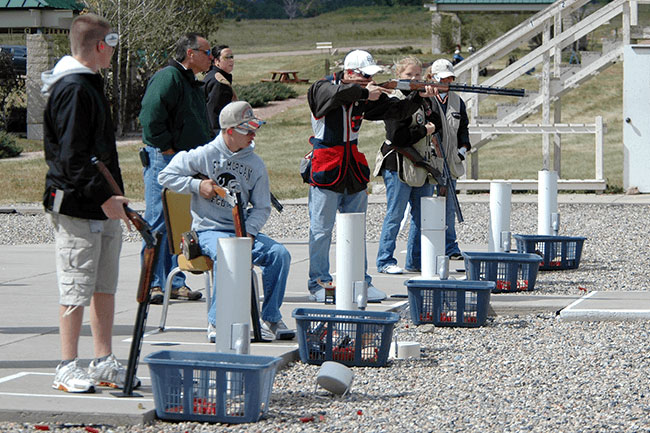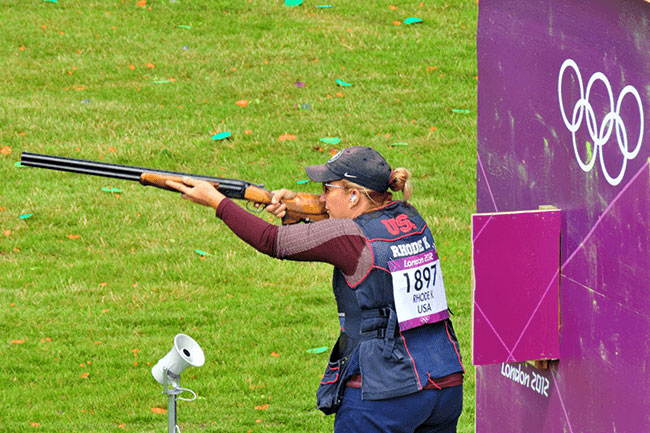Getting Started with Trap Shooting
During the 18th century, European hunters began releasing live pigeons from “traps,” which usually consisted of a hat placed over the bird prior to its release. That’s how the sport got its name, but today live pigeons have been replaced by clay discs (which are often referred to as “clay pigeons” in reference to the early use of live birds). Trap ranges are found throughout the country, and it’s a safe bet that there’s a range not far from you.
“Perhaps the most confusing five minutes a person can spend in their life is the first five minutes on a trap field,” says Gil Ash of OSP Shooting School. In this video, aptly titled “How to Shoot Trap,” Gil provides a great synopsis for those new to trapshooting. He explains how he approaches each station on a trap field. By knowing the proper hold points and focal points for each station, you can see great results from the start.
How The Game is Played
In modern competitive trap, all clay targets are thrown from a “house” or “bunker” set in the ground at the center front of the trap field (trap fields are often created using the same field skeet shooters utilize). The clays fly up and away from the shooters (from beneath and in front of them), who are positioned behind the trap house on the “ shooting line.” The clays are thrown from a machine that oscillates from left to right, and because the machine is out of sight from the shooters, the shooters don’t know which way the clay bird is going to travel until they call for it. This unpredictability in target flight is one of the elements that makes trap differ from the sport of skeet.
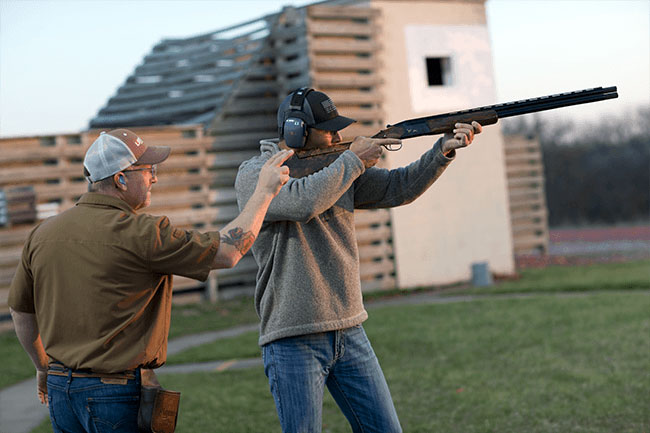
A new shooter gets some mentoring from a more experienced shooter, who’s looking over the shooter’s shoulder to gauge his barrel movement and target acquisition.
Traditional trap course shooting lines have five shooting stations. During a round of trap, up to five shooters will take their places, one on each of the five shooting pads arranged in a slight semi-circle toward the front of the field but behind the bunker. The first shooter, positioned at the far left station (when viewed from behind), calls for their first bird by saying, “Pull.” After their shot, that shooter will show their gun empty, and then it’s the second shooter’s turn to call for a clay target and so on all the way down the line. This rotation repeats until each shooter has fired five shots at their first shooting location. Once every shooter has completed five shots, then the shooters themselves rotates, with the shooters in position one through four moving one shooting pad over to their right (with actions open and guns unloaded), and the shooter in position five moving to the first position. When everyone has shot five times from each station, the round is over, with a total of 25 shots per shooter, which equals the number of shotgun shells in a box of sporting shotgun ammunition.
The key to shooting trap well is to get on target quickly but not rush the shot — something that is easier said than done. To begin, you’ll pre-mount the gun to your shoulder, check on the stock and the muzzle pointed at the ground at the front edge of the trap. With both eyes open, you’ll call for the clay and, when it emerges, you must move the muzzle of the shotgun up to the rising clay smoothly and quickly, pressing the trigger as you reach the target. But don’t stop your swing! If you watch the most experienced trap shooters, they keep the gun moving after they shoot and even if they miss. Do this yourself as you begin to shoot this game and you’ll quickly learn to keep your gun moving in a smooth, fluid motion and resist lifting your head after the shot (which will cause you to stop your swing and miss).
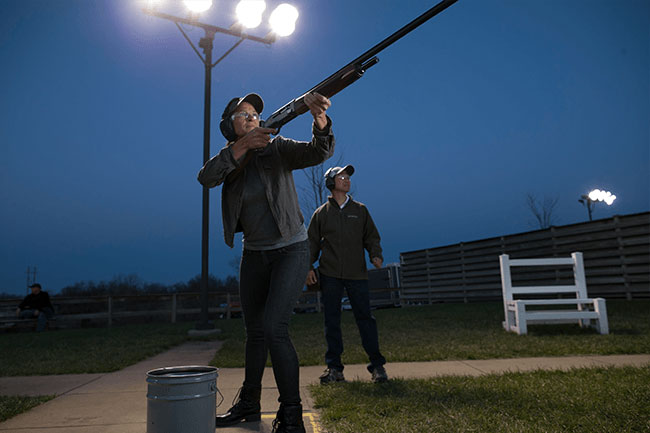
Many trap clubs offer night shooting during the summer, using floodlights to illuminate the fields and allowing shooters to compete when the sun goes down and things are a little cooler.
Shotguns for Trap
Trap shotguns typically have long barrels with a weight-forward balance. Traditionally, trap guns pattern higher than other shotguns, because the clay bird is almost always rising when the shot is fired. For comparison, the typical field gun may pattern 50/50, meaning that half of the shot rises above the bead the shooter sees in their periphery when firing, while the other half stays below Trap guns are often designed to shoot 70/30 or even higher. This allows the shooter to aim under the bird and send most of the shot above the line of sight, which helps break rising birds. Many competitive trap shotguns also offer adjustable ribs and combs so that shooter can “sight” the gun in to fit their particular facial architecture and shooting style. Learn more about the different types of shotguns here.
What ammunition is appropriate for trap shooting? Twelve-gauge target loads with No. 7½ or 8 shot are the norm. Any store-bought target load will work, though many competitive shooters prefer faster (higher velocity) trap-specific loads or hand load their own ammunition. Learn more about shotgun shells here.
Competitive Trap Today
Trap became a recognized Olympic sport in 1900, and the event is still part of the summer Olympics. There are two primary trap events, American and International. In American trap, which is most common in the United States, the bunker houses a single trap machine that rotates or oscillates as I said before, in a range of 45 degrees to throw its targets. International trap, however, houses 15 separate traps in a 60-foot bunker (three traps in front of each shooter) and each of those traps is positioned to throw targets at various angles. In addition, international trap throws targets are varying speeds, and because of this extra challenge shooters are allowed to take two shots at each target. International trap is challenging — but don’t think the American version is without its difficulties. Many would say that it’s easy to get good enough to shoot a perfect round of trap. It can be when you’re shooting from the first set of pads closest to the bunker, which are 16 yards behind it. That’s why American trap also has “handicap” yardage that positions shooters further and further back after each perfect round is shot. The best shots fire from as much as 27 yards behind the bunker — and that’s where there’s no room for error, to be sure.
Trap shooting can be an exciting way to improve your shooting, and after you start breaking a few clays you’ll want to come back time and again to continue to improve your scores. If you become proficient, you may enter events at local clubs. I was a member of my university’s trap and skeet team, and that offered me a great opportunity to meet other shooters while improving my game. The Amateur Trapshooting Association (ATA) is the largest trap shooting organization in the United States, and its website, www.shootata.com, lists clubs and competitive events around the nation.
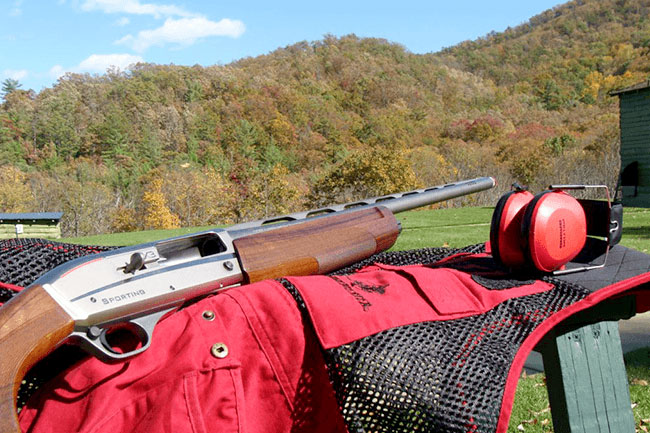
A simple shotgun, a shooting vest, eye and ear protection and a box of shotshells are all you need to get started shooting trap.
Getting started in trap shooting requires only a shotgun, a shotgun shooting vest, hearing and eye protection and a few boxes of shells. Best of all, most experienced shooters are willing to help novices, so ask a lot of questions from them when you see them shooting at your local club. As it was for me when I was shooting in college, you will almost certainly come away with new friends, new mentors and new shooting skills you can be proud of. Learn more about the shotgun sports here.
